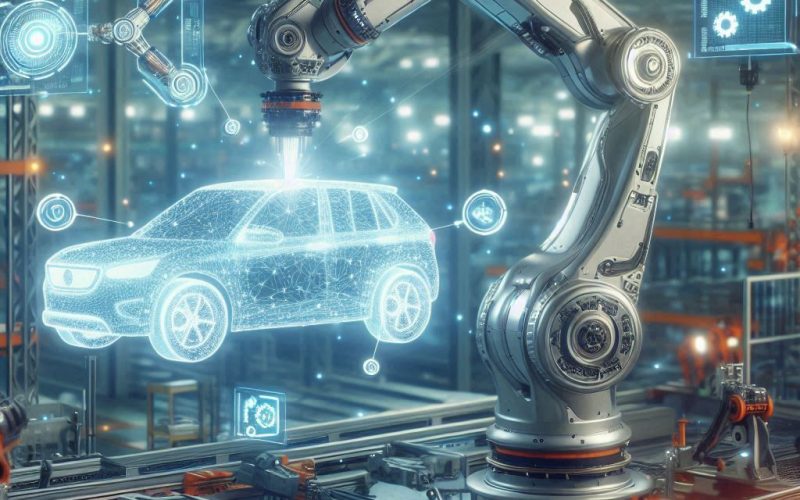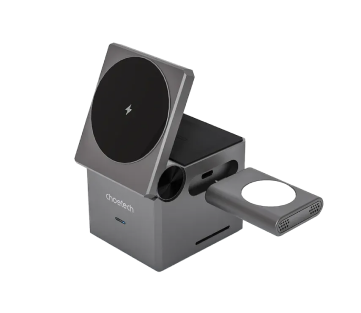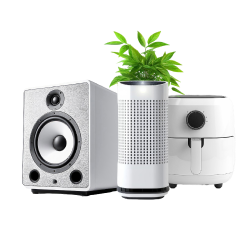The integration of Artificial Intelligence into the field of robotics is revolutionizing industries worldwide, particularly in manufacturing. Robotics in manufacturing is not just a trend; it represents a pivotal shift in how products are designed, produced, and distributed.
This article delves into the profound impact AI-driven robotics is having on manufacturing, exploring the evolution, types, current trends, benefits, and challenges associated with this technological advancement.
By understanding these facets, businesses can better navigate the rapidly changing landscape and harness the potential of robotics in manufacturing to enhance efficiency, productivity, and innovation.
Table of Contents
The Evolution of Robotics in Manufacturing
The evolution of robotics in manufacturing is a journey marked by significant technological advancements and milestones. Understanding this progression provides valuable insights into how current systems came to be and what the future might hold for robotics in the industry.
Early Beginnings
The journey of robotics in manufacturing began in the mid-20th century with the introduction of automated systems designed to handle repetitive and dangerous tasks. The Unimate, the first industrial robot, was deployed on a General Motors assembly line in 1961. It performed simple yet critical tasks such as welding and material handling. This marked the dawn of a new era where machines began to complement human labor in manufacturing processes.
Integration of AI
The integration of AI into robotics brought a transformative leap in the capabilities of these machines. Early robots operated on pre-programmed instructions, which limited their flexibility and adaptability. However, AI introduced elements of machine learning, computer vision, and natural language processing, enabling robots to learn from their environment, make decisions, and perform complex tasks with precision. This evolution transformed robots from mere automated tools into intelligent systems capable of revolutionizing manufacturing processes.
Rise of Collaborative Robots (Cobots)
The development of collaborative robots, or cobots, represents another significant milestone in the evolution of robotics in manufacturing. Unlike traditional industrial robots that operate in isolation, cobots are designed to work alongside human workers, enhancing their capabilities and improving productivity. These robots are equipped with advanced sensors and AI algorithms that allow them to safely interact with humans, adapt to dynamic environments, and perform tasks that require a high degree of dexterity and precision.
Types of Robotics in Manufacturing
The diverse types of robotics in manufacturing each bring unique capabilities and advantages to the production floor. Exploring these robotic systems helps us understand how they contribute to various aspects of manufacturing processes and enhance overall efficiency.
Autonomous Mobile Robots (AMRs)
Autonomous Mobile Robots (AMRs) are used extensively in manufacturing for material handling and transportation. Equipped with AI and advanced navigation systems, AMRs can independently navigate complex factory environments, avoiding obstacles and optimizing their routes. This reduces the need for human intervention and enhances the efficiency of intra-factory logistics.
Articulated Robots
Articulated robots, often referred to as robotic arms, are among the most common types used in manufacturing. These robots are characterized by their rotary joints, which allow for a wide range of motion. They are highly versatile and can be programmed to perform various tasks such as welding, assembly, and painting. The integration of AI further enhances their capabilities by enabling precise control and adaptability to different tasks.
Collaborative Robots (Cobots)
Collaborative robots, or cobots, are designed to work alongside human workers, enhancing productivity and safety. These robots are equipped with advanced sensors and AI algorithms that enable them to safely interact with humans and adapt to dynamic environments. Cobots are used in various manufacturing processes, including assembly, packaging, and quality control, where they complement human skills and improve overall efficiency.
Machine Vision Robots
Machine vision robots leverage AI and advanced imaging technologies to perform tasks that require visual recognition and inspection. These robots are used in quality control processes to detect defects, measure dimensions, and ensure product consistency. By analyzing visual data, machine vision robots can identify anomalies and make real-time adjustments, significantly enhancing product quality and reducing waste.
Autonomous Guided Vehicles (AGVs)
Autonomous Guided Vehicles (AGVs) are used to transport materials and goods within manufacturing facilities. These robots follow predefined paths and are equipped with sensors and AI algorithms to avoid obstacles and ensure safe navigation. AGVs are commonly used in large-scale manufacturing operations to automate the movement of raw materials, work-in-progress items, and finished products, thereby improving overall logistics efficiency.
Current Trends and Innovations
The manufacturing industry is continuously evolving, driven by technological advancements that introduce new trends and innovations. Staying informed about these current developments is crucial for manufacturers looking to maintain a competitive edge and optimize their operations.
AI-Driven Predictive Maintenance
One of the most significant trends in robotics in manufacturing is the use of AI-driven predictive maintenance. By leveraging machine learning algorithms and IoT sensors, manufacturers can monitor the health of their robotic systems in real-time. Predictive maintenance involves analyzing data from sensors to predict when a robot or machine is likely to fail, allowing for timely maintenance and reducing downtime. This not only improves the reliability of manufacturing processes but also extends the lifespan of expensive equipment.
Enhanced Human-Robot Collaboration
The future of robotics in manufacturing lies in enhanced human-robot collaboration. Advances in AI and sensor technology are enabling robots to work more closely with humans, sharing tasks and complementing each other's strengths. Collaborative robots, or cobots, are designed to operate alongside human workers, performing tasks that require precision and repetitive actions while humans focus on more complex and creative aspects of production. This synergy between humans and robots leads to increased productivity and innovation.
AI-Optimized Production Planning
AI is also revolutionizing production planning in manufacturing. AI algorithms analyze vast amounts of data, including demand forecasts, inventory levels, and production schedules, to optimize production plans. This results in better resource allocation, reduced lead times and minimized production costs. AI-driven production planning ensures that manufacturers can meet customer demands efficiently while maintaining high levels of quality and consistency.
Advanced Quality Control
AI-powered quality control systems are transforming the way manufacturers ensure product quality. Machine vision systems, equipped with AI algorithms, can detect defects, measure dimensions, and inspect products at a level of accuracy that surpasses human capabilities. These systems can analyze visual data in real time, identifying even the smallest deviations from quality standards. This leads to higher product quality, reduced waste, and increased customer satisfaction.
Intelligent Supply Chain Management
The integration of AI in robotics is also enhancing supply chain management in manufacturing. AI algorithms analyze data from various sources, including suppliers, production facilities, and distribution networks, to optimize supply chain operations. This includes demand forecasting, inventory management, and logistics planning. By using AI to streamline supply chain processes, manufacturers can reduce costs, improve delivery times, and ensure a more responsive and resilient supply chain.
Benefits of Robotics in Manufacturing
Robotics can significantly enhance operational capabilities when integrated into manufacturing processes. By understanding these benefits, manufacturers can better appreciate the value that robotics adds to their production lines.
Increased Efficiency and Productivity
The integration of robotics in manufacturing significantly increases efficiency and productivity. Robots can perform tasks faster and with greater precision than human workers, reducing production times and minimizing errors. This leads to higher output levels and allows manufacturers to meet customer demands more effectively. Moreover, robots can work continuously without breaks, further enhancing productivity.
Enhanced Precision and Consistency
Robots are capable of performing tasks with a level of precision and consistency that is difficult for humans to achieve. This is particularly important in industries where even minor deviations can lead to significant issues, such as in electronics manufacturing. By ensuring consistent quality and accuracy, robots help maintain high standards and reduce the likelihood of defects.
Improved Safety
One of the primary benefits of using robotics in manufacturing is the improved safety of workers. Robots can take on dangerous and physically demanding tasks, such as handling hazardous materials or performing heavy lifting, which reduces the risk of workplace injuries. Additionally, the use of collaborative robots ensures that humans can work safely alongside robots without the need for extensive safety barriers.
Cost Savings
While the initial investment in robotics technology can be substantial, the long-term cost savings are significant. Robots can operate continuously, reducing labor costs and increasing production efficiency. They also minimize waste and rework by performing tasks with high precision. Furthermore, AI-driven predictive maintenance reduces downtime and extends the lifespan of equipment, leading to additional cost savings.
Flexibility and Scalability
Modern robotics systems are highly flexible and scalable, allowing manufacturers to adapt to changing production needs quickly. Robots can be reprogrammed to perform different tasks, enabling manufacturers to switch between product lines without extensive reconfiguration. This flexibility is particularly valuable in industries with rapidly changing market demands, such as consumer electronics and automotive manufacturing.
Enhanced Data Collection and Analysis
Robotics systems equipped with AI and IoT sensors generate vast amounts of data during production processes. This data can be analyzed to gain valuable insights into production efficiency, equipment performance, and product quality. By leveraging this data, manufacturers can make informed decisions, optimize processes, and continuously improve their operations.
Challenges and Considerations
Despite the numerous benefits that robotics brings to manufacturing, there are several challenges and considerations that manufacturers must address. Understanding these potential obstacles is essential for the successful implementation and long-term integration of robotics in manufacturing processes.
High Initial Investment
The adoption of robotics in manufacturing requires a significant initial investment. The cost of purchasing, installing, and maintaining robotic systems can be substantial, especially for small and medium-sized enterprises (SMEs). However, the long-term benefits and cost savings often justify the initial expenditure. Manufacturers need to carefully evaluate their financial capabilities and consider the potential return on investment before implementing robotics technology.
Technical Complexity
Implementing robotics systems in manufacturing involves a high level of technical complexity. Integrating robots with existing production processes, ensuring compatibility with software systems, and managing data flows require specialized knowledge and expertise. Manufacturers may need to invest in training their workforce or hiring skilled professionals to handle the technical aspects of robotics implementation.
Workforce Adaptation
The integration of robotics in manufacturing can lead to significant changes in the workforce. While robots take on repetitive and physically demanding tasks, human workers are required to perform more complex and strategic roles. This shift necessitates upskilling and reskilling the workforce to adapt to new job requirements. Manufacturers must invest in training programs to ensure their employees can effectively collaborate with robots and leverage the benefits of automation.
Cybersecurity Risks
The increasing connectivity of robotics systems in manufacturing introduces cybersecurity risks. As robots become more integrated with IoT and AI technologies, they become potential targets for cyberattacks. Manufacturers need to implement robust cybersecurity measures to protect their robotic systems and sensitive data from unauthorized access and malicious activities.
Ethical and Social Implications
The widespread adoption of robotics in manufacturing raises ethical and social considerations. Concerns about job displacement, worker safety, and the impact on local communities need to be addressed. Manufacturers must adopt a balanced approach that prioritizes both technological advancement and the well-being of their workforce. Engaging with stakeholders, including employees, labor unions, and local communities, is crucial to ensuring a fair and responsible implementation of robotics technology.
Future Prospects and Emerging Technologies
Here, we explore the emerging technologies and future prospects that promise to further revolutionize robotics in manufacturing, driving the industry towards greater efficiency, sustainability, and innovation.
Advanced AI Integration
As AI technology continues to advance, its integration into robotics in manufacturing is set to become even more sophisticated. Future AI systems will be capable of more nuanced decision-making and problem-solving, enabling robots to handle highly complex tasks with minimal human intervention. This includes self-learning robots that can adapt to new environments and tasks through continuous learning algorithms.
Quantum Computing
Quantum computing holds the potential to revolutionize robotics in manufacturing by providing unparalleled processing power for complex simulations and optimizations. Quantum algorithms could enhance AI capabilities, enabling robots to solve problems and make decisions at unprecedented speeds. This would lead to more efficient production processes, reduced waste, and innovative manufacturing solutions that are currently beyond the reach of classical computing.
Augmented Reality (AR) and Virtual Reality (VR)
AR and VR technologies are set to play a significant role in the future of robotics in manufacturing. These technologies can enhance human-robot interaction by providing immersive training environments and real-time visualizations of robotic operations. AR can assist workers in performing complex tasks by overlaying digital instructions and information onto the physical workspace, while VR can simulate various manufacturing scenarios for training and optimization purposes.
5G Connectivity
The rollout of 5G technology will greatly enhance the capabilities of robotics in manufacturing by providing faster and more reliable communication between devices. This will enable real-time data sharing and collaboration between robots and other smart devices in the manufacturing ecosystem. The increased bandwidth and low latency of 5G will support the deployment of more advanced AI algorithms and IoT applications, further enhancing the efficiency and productivity of manufacturing processes.
Biologically Inspired Robotics
Biologically inspired robotics, or bio-robotics, involves designing robots that mimic the structure and function of biological organisms. These robots can perform tasks with greater flexibility and adaptability, similar to living creatures. In manufacturing, bio-robots could be used for delicate assembly tasks, intricate material handling, and other applications that require a high degree of dexterity and precision. This emerging field holds promise for developing more versatile and efficient robotic systems.
Sustainability and Green Manufacturing
Future advancements in robotics in manufacturing will increasingly focus on sustainability and green manufacturing practices. Robots can be designed to minimize energy consumption, reduce waste, and optimize the use of resources. AI algorithms can also help manufacturers identify and implement more sustainable production methods. As environmental concerns continue to grow, the development of eco-friendly robotic solutions will be crucial for achieving sustainable manufacturing goals.
Human-Centric Robotics
The future of robotics in manufacturing will emphasize human-centric designs that prioritize the well-being and productivity of human workers. This includes developing ergonomic robots that reduce physical strain on workers, as well as systems that enhance cognitive and decision-making capabilities. By focusing on the human element, manufacturers can create a more harmonious and productive work environment where humans and robots collaborate effectively.
Autonomous Systems and Robotics Swarms
Autonomous systems and robotics swarms represent the next frontier in manufacturing automation. Autonomous systems, guided by advanced AI, can operate independently and make real-time decisions based on dynamic conditions. Robotics swarms, consisting of multiple robots working together in a coordinated manner, can perform complex tasks more efficiently and flexibly than a single robot. These technologies will enable highly adaptive and resilient manufacturing processes capable of responding to rapidly changing demands and challenges.
By exploring and investing in these future prospects and emerging technologies, manufacturers can stay at the forefront of innovation and ensure the continued evolution and enhancement of robotics in manufacturing. This proactive approach will not only drive competitive advantage but also pave the way for more sustainable, efficient, and human-centric manufacturing practices.
Conclusion
The integration of AI in robotics is revolutionizing the field of manufacturing, bringing unprecedented levels of efficiency, precision, and innovation. From the early beginnings of automated systems to the current advancements in AI-driven robotics, the evolution of robotics in manufacturing has been remarkable.
The various types of robotics, including AMRs, articulated robots, cobots, machine vision robots, and AGVs, are transforming production processes across industries.
Current trends and innovations, such as AI-driven predictive maintenance, enhanced human-robot collaboration, AI-optimized production planning, advanced quality control, and intelligent supply chain management, are shaping the future of manufacturing.
These advancements offer numerous benefits, including increased efficiency, enhanced precision, improved safety, cost savings, flexibility, and enhanced data collection and analysis.
However, the adoption of robotics in manufacturing also presents challenges and considerations, including high initial investment, technical complexity, workforce adaptation, cybersecurity risks, and ethical implications. Manufacturers need to navigate these challenges carefully and adopt a balanced approach that maximizes the benefits of robotics while addressing the concerns of all stakeholders.



